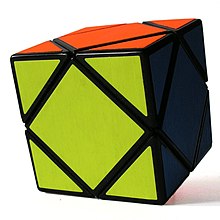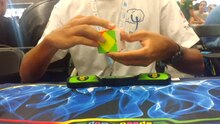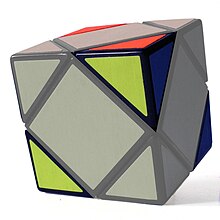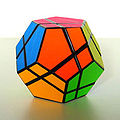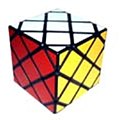Skewb
The Skewb ( pronunciation : [ skjuːb ]) is a cube-shaped rotating puzzle in the style of a magic cube . Since January 1, 2014, the skewb has been a discipline of the World Cube Association (WCA) in speed cubing , which is often played at championships.
History and naming
The Skewb was invented by the London journalist Tony Durham and marketed by the German Uwe Mèffert . The original name of the cube was initially Pyraminx Cube in 1982 . This name is intended to give an indication of the basic mechanics used and to emphasize that he was part of a series that also includes his tetrahedral puzzle Pyraminx . The name “Skewb” comes from a paper by the American physicist Douglas R. Hofstadter in the journal Scientific American in 1982. The new word “Skewb” is made up of the English words skew [skjuː] (crooked) and cube [kjuːb] ( Cube) and describes the shape of the puzzle as well as the oblique orientation of the axes of rotation. Mèffert liked this name, so he adopted it for his rotating puzzle.
description
With an edge length of 55 mm, the Skewb has roughly the same dimensions and the same basic shape as the original Rubik's Cube , but the axes of rotation do not run through the center of the surface of the cube, as in the construction by Ernő Rubik , but through the cube corners, i.e. along the four space diagonals of the cube. The cube can only be rotated along planes through the center of the cube, each rotation corresponding to 120 °. The corners of the cube cannot be rotated individually. Since the planes of rotation run through all outer surfaces of the cube, a rotation in such a plane means a change in all six sides of the cube.
The arrangement of the cutting planes divides each surface of the cube into five parts, resulting in a central square on top and four triangles in the corners. The aim of the rotating puzzle is to twist it so that each cube surface is made up of only one color (yellow, orange, blue, white, red or green).
Construction and construction
At first glance, the eight corners of the skewb appear to be equivalent. However, a closer look shows that the corners react differently to pressure. The corners can be divided into two groups, each of which is connected by the diagonals of the surface of the cube. Cube corners that are right next to each other belong to different groups.
In the Skewb, four of the eight cube corners inside are connected to each other via axes at a fixed angle of 109.5 degrees to form a regular tetrahedron. The relative position of these "fixed" corners to one another is therefore always the same due to the design, although the corners at the end of the connections can themselves be rotated around the axis of rotation.
The other four “free” corners arranged between the “fixed” corners are not rigidly anchored to the center, but also form a regular tetrahedron. The relative position of the “free” corners is also the same, apart from a twisting of the corners. However, the orientation of the tetrahedron of the "free" corners in space is independent of the orientation of the tetrahedron of the "fixed" corners, so that the relative position of a "free" corner to a "fixed" corner changes due to the rotation. However, there is no exchange between the two types of corners.
Between the corners there are six square plates, which are also only clamped into the construction without being firmly connected to the center. Because of the degrees of freedom when twisting, there are also restrictions with regard to these squares. So it is impossible to swap exactly two squares.
Mathematics and statistical consideration
| n | p |
|---|---|
| 0 | 1 |
| 1 | 8th |
| 2 | 48 |
| 3 | 288 |
| 4th | 1,728 |
| 5 | 10,248 |
| 6th | 59,304 |
| 7th | 315.198 |
| 8th | 1,225,483 |
| 9 | 1,455,856 |
| 10 | 81,028 |
| 11 | 90 |
| total | 3,149,280 |
By coupling the corners and the type of rotations allowed, 3,149,280 different, distinguishable arrangements are possible with the standard Skewb. The significantly lower number of arrangements compared to the normal Rubik's Cube (4 × 10 19 possibilities) does not mean that the difficulty of solving the rotating puzzle is proportionally reduced.
The number of possible arrangements is so small that a complete simulation of solutions can be calculated with the computer. These simulations show that every twist of the standard skewb can theoretically be solved in a maximum of 11 moves. In the table opposite, the number of minimally required moves n is compared to the number of permutations p (distinguishable arrangement).
Due to the mechanics, the orientation and the position of the puzzle pieces are subject to numerous restrictions (see above). If the cube were to be dismantled into its individual parts and then arbitrarily reassembled without changing the sticker, only about 0.02% of all cubes created in this way would be detachable by turning.
World records
The World Cube Association has held championships in the skewb discipline since 2014.
The world record in speed cubing for this cube (single solve) is 0.93 seconds and was set by Andrew Huang on November 11th – 14th. July 2019 at the WCA World Championship 2019 .
There is also the “Average Solve” discipline, in which a participant has five attempts and the best and worst results are deleted and the average of the three remaining results is calculated. The world record here is 2.03 seconds and was set by Łukasz Burliga on 16. – 17. December 2017 at the Grudziądz Open 2019 .
Variants of the puzzle
Even if the external shape of the rotating puzzles is very different, a similar, tetragonal basic building block is in many of them. Numerous variants are counted in the family of Skewb rotating puzzles.
Individual evidence
- ^ David Joyner: Adventures in Group Theory: Rubik's Cube, Merlin's Machine, and Other Mathematical Toys . JHU Press, 2002, ISBN 978-0-8018-6947-1 , pp. 59 ( google.de [accessed December 28, 2018]).
- ↑ Uwe Meffert: The Long History of Pyraminx and its offspring's. November 6, 2017, accessed December 28, 2018 .
- ↑ a b c d e f Douglas Hofstadter: Metamagical Themes: Questing For The Essence Of Mind And Pattern . Basic Books, 2008, ISBN 978-0-7867-2386-7 ( google.de [accessed December 29, 2018]).
- ^ Douglas R. Hofstadter: "METAMAGICAL THEMAS: Beyond Rubik's Cube: spheres, pyramids, dodecahedrons and God knows what else," . In: Scientific American . tape 247 , no. 1 , July 1982, p. 16-31 .
- ↑ Z3Cubing: Skewb Disassembly and Assembly Tutorial (v2). (Video) In: youtube.com. May 24, 2015, accessed December 29, 2018 .
- ↑ a b Skewb. In: Jaap's Puzzle Page. Jaap Scherphuis, accessed on December 29, 2018 .
- ^ David Joyner: Adventures in Group Theory: Rubik's Cube, Merlin's Machine, and Other Mathematical Toys . JHU Press, 2008, ISBN 978-0-8018-9726-9 ( google.de [accessed December 30, 2018]).
- ↑ List of Skewb Single World Records on the World Cube Association website
- ↑ List of Skewb Average world records on the World Cube Association website
